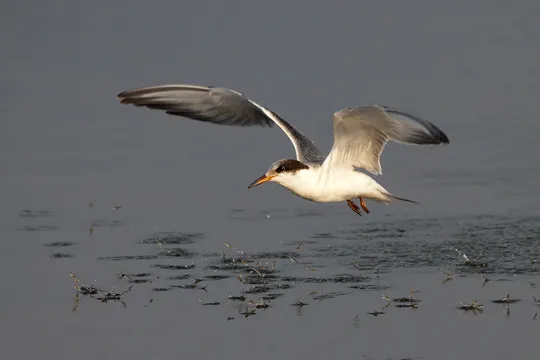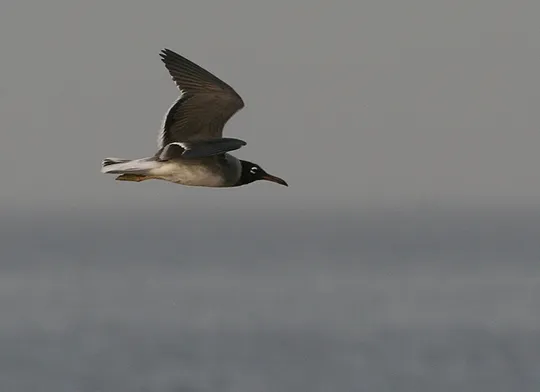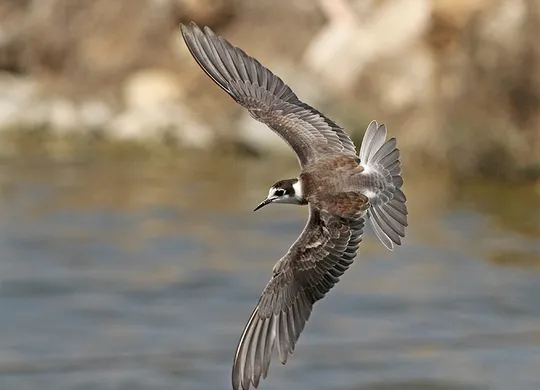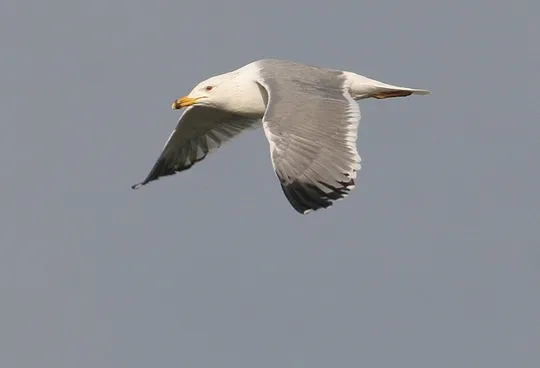Sterna albifrons
 Endangered
Endangered

| Habitats | Salt Ponds, Wetlands with Shallow Banks |
|---|---|
| Presence In Israel | Migrant, Summer |
| Breeding In Israel | Breeder |
| Migration Types | Long Range |
| Zoographical Zones | Mediterranean |
| Landscape Types | Wetlands, Salt Ponds, Sandy Beach, Mud Plain |
| Vegetation Densities | Low |
| Nest Locations | Ground |
| Diet Types | Fish |
| Foraging Grounds | Water |
| Body Sizes | Small (up to 500g) |
| Threat Factors | Wetland Drainage & Pollution, Direct disturbance from human activity, Increased predation from invasive and eruptive species |
The smallest tern found in Israel. It is about the size of a bulbul and easily identified by its white forehead and yellow bill and legs. Flight is rapid and restless and when hunting it hovers rapidly, plunging into the water after fish, and rising rapidly once again. A long-distance migrant in which the Israeli population apparently overwinters in East Africa.
The Little Tern is a rare summer visitor and relatively common passage migrant, particularly along the Mediterranean coast and the Gulf of Eilat. It was first discovered breeding in Israel in 1953, when the Hula Lake was drained, and since the 1970s has been breeding in the Atlit saltpans. The number of breeding pairs at Atlit has increased gradually from a few pairs to 100-250 in the 1980s and 1990s (Yossi Eshbol, pers. comm.). At that time, a few pairs also nested in the Hula Valley, northern Sea of Galilee and the Jezreel Valley (Shirihai 1996). The few attempts at nesting along the Mediterranean coast mostly ended in failure because of human disturbance. About 1,000 breeding pairs were observed at the Bardawil Lagoon in Northern Sinai in the 1970s and 1980s. Currently Little Terns nest regularly in the in the Atlit saltpans breeding colony and in small satellite colonies in the fishponds and reservoirs of the Carmel Coast. The breeding population arrives in Israel during April and leaves in August-September.
The Little Tern nests on sandy shores or the edges of dirt roads and on sand and mud banks around ponds and reservoirs.
The Little Tern population nesting on the Carmel Coast numbers between 200 and 260 pairs.
Little Tern breeding is now almost completely concentrated in one major colony in the Atlit saltpans. This alone is evidence of the threat to the continued existence of the species in Israel. The saltpans have no statutory protection and some of them may be converted to other uses. Moreover, the colony is sometimes threatened by predators such as foxes and jackals as well as by diseases such as the Newcastle Disease Virus (Goldstein, Kiat & Hatsofe 2017).
The Little Tern breeding islet in the Atlit saltpans is constantly monitored. It has been expanded and raised to prevent nest flooding and fenced to prevent predator invasion. Attempts to restore breeding on the Mediterranean coast have not been successful.
The Little Tern is a migratory species that is endangered because of its small population, which is dependent on artificial habitat and active management. Most of the species population is concentrated in the Atlit saltpans, which is a private industrial area. In the past, large breeding colonies were recorded on the Northern Sinai coast, but there is no updated information regarding their status.
Monitoring and preservation efforts should be continued in order to ensure the future of the Little Tern in Israel, which now nests in areas that have no statutory protection to ensure their preservation.
- הצופה, א. ומירוז, א. 2009. קינון שחפיות בישראל - תמונת מצב והמלצות לממשק. מסמך פנימי של רשות הטבע והגנים והחברה להגנת הטבע.
- פז, ע. 1986. עופות. מתוך אלון, ע. (עורך), החי והצומח של ארץ ישראל. כרך 6. הוצאת משרד הביטחון, ישראל.
- ריבק, א., כיאט, י., גולדשטיין, ע., והצופה, א. 2017. קינון שחפיות בחוף הכרמל - סיכום עונת 2017.
- Shirihai, H., 1996. The Birds of Israel. Academic Press, London.
- Symes, A. 2013. Species generation lengths. Unpublished, BirdLife International.
- Species page at Birdlife International
Current Occupancy Map
| Data Missing | Sporadic | Limited Sites | Low Density | High Density |
|---|---|---|---|---|
| 0 | 0 | 0 | 0 | 0 |
Distribution maps
The maps presented here provide visual information on the distribution of species in Israel from the past and present, and the changes in occupancy and breeding density during the comparison period. For further reading
Relative Abundance 2010-2020
Breeding density values in the current decade as determined from experts' opinion and observations from databases.
| Data Missing | Sporadic | Limited Sites | Low Density | High Density |
|---|---|---|---|---|
| 8 | 12 | 12 | 21 | 19 |
Relative Abundance 1980-1990
Density values based primarily on the book The Birds of Israel (Shirihai 1996).
| Data Missing | Sporadic | Limited Sites | Low Density | High Density |
|---|---|---|---|---|
| 5 | 14 | 14 | 17 | 22 |
Occupancy 1990-2020
The map shows differences in the species breeding distribution between the 1980's breeding map and the current weighted breeding evaluation. Negative value - species previously bred in the grid and is not presently breeding; positive value - species has not previously bred in the grid and is currently breeding.
| Data Missing | No Change | Occupancy Increase | Occupancy Decrease |
|---|---|---|---|
| 6 | 35 | 1 | 9 |
Change in Relative Abundance 1990-2020
The map shows the changes in the relative abundance of a species in each of the distribution grids between the breeding map of the 1980s and the weighted current breeding evaluation. Negative values - decline in abundance; positive values - increase in abundance; zero - no change in abundance.
| 80 to 100 | 50 | 20 to 30 | No Change | 30- to 20- | 50- | 100- to 80- | Data Missing |
|---|---|---|---|---|---|---|---|
| 0 | 4 | 2 | 22 | 12 | 14 | 11 | 16 |
| Rarity | |
|---|---|
| Vulnerability | |
| Attractiveness | |
| Endemism | |
| Red number | |
| Peripherality | |
| IUCN category | |
| Threat Definition according to the red book |
 Contributed:
Contributed: 





